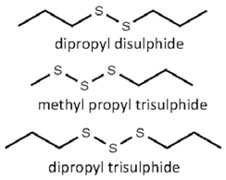 Allium fistulosum
Allium fistulosum
Welsh onion • Japanese bunching onion
Back to “Salad herbs and herb mixtures: Japanese bunching onion (Allium fistulosum); Welsh onion (Allium fistulosum)”
Back to “Culinary herbs: Japanese bunching onion (Allium fistulosum); Welsh onion (Allium fistulosum)”
Allium fistulosum L. (Alliaceae); Walliese ui, groenui (Afrikaans); cong, da cong (Chinese); duan bawang (Indonesian); ciboule (French); Winterzwiebel (German); cipolo d’inverno, cipoletta (Italian); negi (Japanese); daun bawang (Malay); cebolinha commun (Portuguese); ceboletta comun (Spanish); ton horm (Thai)
DESCRIPTION The fleshy stems (about the thickness of a finger) are without distinct bulbs and bear hollow leaves with an inflated appearance (fistulosum means “hollow”). It is variously known as scallion, green onion, bunching onion or salad onion (USA), Welsh onion (England), ciboule (France) and negi (Japan).1 It is superficially similar to leeks (A. ameloprasum) but the latter have flat leaves.
THE PLANT A robust perennial herb, easily distinguished by the tufted habit, absence of bulbs, hollow leaves and rounded clusters of small white flowers.
ORIGIN A cultigen of Chinese origin. This is the original Chinese garden onion (recorded 100 BC) which spread to Japan (recorded ad 720). “Welsh onion” is derived from the German or old English word welsche (meaning foreign). “Spring onion” may refer to this species or to young onions (A. cepa) that are used in the same way. Scallion or shallot (A. cepa var. ascalonicum) is also a type of bunching onion that can be confused with Welsh onion. The name “Chinese onion” is best avoided due to a possible confusion with A. chinense. “Chinese chives” is the name of yet another species (see A. tuberosum).1,2
CULTIVATION This species (unlike onion) can be sown almost any time of the year or the tufts can be divided. Welsh onion and various hybrids with A. cepa (such as ‘Beltsville Bunching’ in the USA) have become popular as annual crops. They are best grown in full sun but will tolerate some shade. Aphids may be troublesome. Cultivars can be short and thick (e.g. ‘Shimonita’), red-skinned (e.g. ‘Red Beard’ and ‘Santa Clause’) or have slightly bulbous bases (e.g. ‘Yoshima’).
HARVESTING Stems with leaves are cut any time of the year – one of few vegetables that can be harvested all year round.
CULINARY USES Welsh onion is a traditional ingredient of oriental cooking, used in stir-fries and in many other dishes. The stems and leaves are eaten fresh as an ingredient of salads and are often seen as garnishes, shaped into distinctive brushes or tassels.
FLAVOUR COMPOUNDS The mild, onion-like flavour is derived from sulphur-containing compounds such as isoalliin and methiin that are enzymatically modified to form volatile sulphides via thiosulphinate intermediates (only 0.08 μmol thiosulphinates per g fresh weight, hence the mild flavour).3 The main volatile compounds in A. fistulosum are dipropyl disulphide (30%), methyl propyl trisulphide and dipropyl trisulphide.4

NOTES Leeks (Allium ameloprasum, formerly known as A. porrum) also have a mild flavour (0.15 μmol thiosulphinates per g),3 making them ideal for flavouring soups (French vichyssoise and Scottish “cock-a-leekie”) and stews. There are three groups: ordinary leek (var. porrum), great-headed or Levant garlic (var. holmense) and kurrat (var. kurrat).1 Leeks and kurrat leaves are eaten as vegetables while Levant garlic bulbs are used as a mild seasoning.
1. Fritsch, R.M., Friesen, N. 2002. Evolution, domestication and taxonomy. In: Rabinowitch, H.D., Currah, L. (Eds), Allium crop science: recent advances, 5–30. CABI Publishing, New York.
2. Harvey, M.J. 1995. Onion and other cultivated alliums. In: Smartt, J., Simmonds, N.W. (Eds), Evolution of crop plants (2nd ed.), pp. 344–350. Longman, London.
3. Benkeblia, N., Lanzotti, V. 2007. Allium thiosulfinates: chemistry, biological properties and their potential utilization in food preservation. Food 1: 193–201.
4. Pino, J.A., Rosado, A., Fuentes, V. 2000. Volatile flavor compounds from Allium fistulosum L. Journal of Essential Oil Research 12: 553–555.